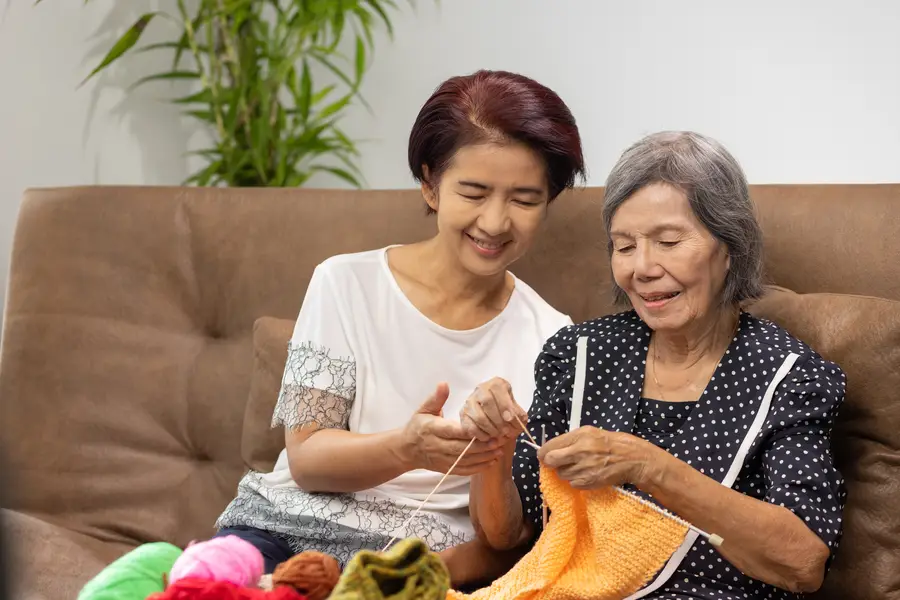In Part 1 of a four-part series, we discuss family caregivers' critical role in the life of dementia patients and explore why they should be included in care planning. Check out Part 2 of the series on identifying and engaging family caregivers, Part 3 on direct-care workers, and Part 4 on the stated needs of family caregivers.
Receiving a dementia diagnosis can be life-altering. Among other challenges, it requires people to consider new ways to take care of everyday needs, including relying on others to complete activities of daily living (ADLs), like dressing, showering, driving, and shopping.
In the face of a dementia diagnosis, a person may not know where to turn for help. Creating an ecological map to identify a patient’s support network is an important early step to help them realize that they are not alone on this journey. Professional caregivers, such as home care or home health workers, are available. However, most ongoing support is provided by informal caregivers—family, friends, and neighbors who are typically not paid or professionally trained but step up to provide care.
In 2020, more than 7 million people aged 65 or older in the United States had dementia. That number is projected to double to 14 million by 2060, according to a 2018 study from the Centers for Disease Control and Prevention. As the number of people with dementia increases in the United States and globally, so too will the need for informal or family caregivers.
In recognition of Alzheimer’s Awareness Month and National Family Caregivers Month this November, we understand the critical role of the dementia caregiver and the need to include them in the care plan.
Informal Dementia Caregivers Provide Critical Assistance
A person may take on a caregiving role for many reasons. One study found the three main reasons are emotional bonds with the person who requires care, a sense of duty, and a feeling of personal obligation. Whatever the reason, informal caregivers provide essential day-to-day supports that help people stay in their homes and communities longer.
According to the Centers for Disease Control and Prevention’s 2018 Behavioral Risk Factor Surveillance System, about 22% of adults reported caring for a family member or friend in the 30 days prior to the survey, and about 10% of those informal caregivers were providing care for someone with a cognitive disorder like dementia. The Alzheimer’s Association estimated the value of informal caregiving provided to people living with dementia (PLWD) in 2021 at $271.6 billion in the United States. Informal caregivers report providing similar types of assistance regardless of diagnosis, but caregivers of PLWD often provide more extensive support in all ADLs, as well as some more unique tasks, like monitoring health, providing emotional support, and helping with communication.
The Importance of Caring for the Caregivers
The role of caregiving can be challenging and comes with physical, emotional, and financial costs. Informal caregivers are more likely than non-caregivers to report feelings of stress and anxiety and to have poor physical health outcomes. These findings are amplified for informal caregivers of PLWD who are more likely than other caregivers to report high emotional stress and burden and significant challenges with financial and physical health. Higher feelings of caregiver burden can also be associated with higher rates of institutionalization of the PLWD.
Despite the physical, emotional, and financial challenges, caregiving can also be rewarding. A systematic review of research on the experiences of informal caregivers of PLWD revealed four main positive aspects: personal gratification, mutual care, increased connection within the dyad, and an improved sense of purpose and growth for the caregiver. Other studies note the importance of identifying positive aspects of caregiving to improve mental health.
Giving Dementia Caregivers a Care Plan of Their Own
So how can we leverage the positive aspects of caregiving while reducing the negative impacts on the informal caregiver? The 2022 National Strategy to Support Family Caregivers suggests one important step is to include informal caregivers in the care planning process. Effective care plans are holistic and family-centered and document the ways in which a patient’s health and other needs can be supported. Including informal caregivers in care planning—and putting the needs of both the patient and caregiver at the center of the care plan—acknowledges the vital role they play in the life of the person they care for and encourages us to think about the support they need to continue in this role.
Informal caregivers often reorganize their professional and personal lives to take on caregiving, and their lack of training and/or aptitude for this role may exacerbate their stress. However, improving a dementia caregiver’s self-efficacy can reduce their sense of burden and improve psychological well-being. By including the caregiver in the care plan, clinicians may be better able to identify their strengths, as well as areas in which they can be supported.
Consider, for example, that a caregiver may need to take on a personal care role for a PLWD as their condition progresses. A care plan that only addresses the PLWD might focus on procuring incontinence supplies; setting up durable medical equipment such as grab bars or shower chairs in the bathroom; or identifying appropriate nutritional supplements. When a caregiver is included in the care plan, however, it also becomes important to consider the emotional impact of taking on this new role and the skills that may be needed to address behaviors and challenges related to toileting, showering, and eating. Those considerations may lead to specific interventions, training, or support that can increase the caregiver’s confidence and comfort in this new role and ensure the safety of his or her charge.
Planning with the caregiver as well as the PLWD in mind will result in a more comprehensive, person-centered plan with a higher chance for success. Each caregiver is unique and should be treated as such in care planning. The National Alzheimer’s and Dementia Resource Center has resources available to help professionals better serve caregivers of all kinds, including webinars related to addressing the needs of caregivers in diverse communities, the unique needs of male caregivers, and the use of community health workers to meet caregivers where they are.
Recognizing People Living with Dementia and Their Caregivers
We have all heard, or may have even told a caregiver, how important it is to take care of ourselves when we are caring for someone else. One way that we can continue to support PLWD and their caregivers is to recognize their unique needs and to provide a formal process for addressing them. Caregivers play a critical role in ensuring quality of life for PLWD. We can do more to support caregivers by including them in care planning.
Learn more about RTI’s Alzheimer’s Disease and Related Dementias (ADRD) capabilities here.


